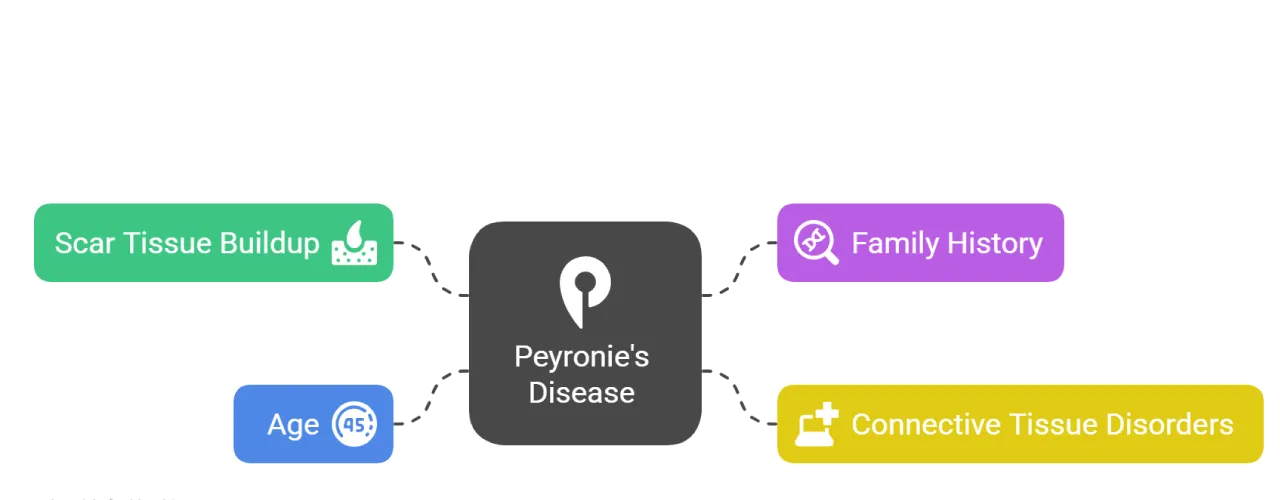Peyronie Disease Treatment
Treatment For Erectile DysfunctionPeyronie’s Disease, or curvature of the penis, is an abnormal bend that builds up scar tissue under the skin of the penis that occurs during erection. The plaques can often be felt through the skin and can be painful. Urologists from Dot Clinics offer treatments to correct your penis size or shape and regain sexual function. Do not feel embarrassed about getting help. Peyronie's disease is a common problem, and it is treatable at our clinic. Dot Clinics in Pakistan offers the most affordable treatments by an internationally certified urology expert.

What is Peyronie’s Disease?
Peyronie’s (pay-roe-NEEZ) disease is a condition in which fibrous scar tissue forms in the deeper tissues under the skin of the penis, causing the penis to curve or lose length or girth. It primarily affects middle-aged men, and the resulting curvature can make sexual intercourse painful and difficult.
Due to the curvature and pain, penetration during intercourse becomes difficult, and penile shortening occurs. If the condition is mild, with only slight curvature and no pain, no treatment is usually required, just observation and proper sexual positioning.
Timely treatment is necessary if Peyronie’s Disease remains for a long time, as it may also cause erectile dysfunction and premature ejaculation.
Dr. Amjad, our urologist at Dot Clinics, advises that surgery is the most effective treatment option for severe cases of Peyronie’s disease. However, for mild to moderate cases, several minimally invasive treatments have shown excellent results, including shockwave therapy, PRP (Platelet-Rich Plasma) therapy, Exosome therapy for penile curvature, and Stem Cell therapy, which promote tissue healing and natural repair.
How common is Peyronie’s disease?
Peyronie’s disease is relatively common, affecting about 1 in 100 men who are diagnosed, although the actual number is estimated to be higher. It is more common in older men, particularly those between the ages of 45 and 70. While it can affect anyone with a penis, it is less common in other age groups. The number of cases may be higher than estimated because many men feel embarrassed and choose not to see their healthcare provider. For this reason, the number of reported cases of Peyronie’s disease may continue to grow.
What is The Difference b/w Peyronie’s Disease & Penile Curvature?
Peyronie’s disease is a type of penile curvature. Some people have penile curvature at birth (congenital penile curvature or chordee). Normal curvature is usually present from birth and stays the same throughout life, without pain or sexual problems. It’s simply a natural variation in shape and doesn’t involve any internal scar tissue.
Peyronie’s disease, on the other hand, develops later in life due to scar tissue (plaques) forming inside the penis. This causes a sudden or worsening bend, often with pain, lumps under the skin, or difficulty during erections. If you notice these changes, it’s important to seek medical advice early, as Peyronie’s disease can often be treated effectively in its early stages.
Symptoms of Penile Curvature
Peyronie's disease symptoms might start suddenly or appear over time. You may also be able to feel scar tissue under the skin. The following are the most common signs and symptoms of Peyronie’s Disease.
- The main symptoms of Peyronie’s Disease include penile curvature upward during erection.
- Sometimes plaque under the skin causes the penis to bend to one side or downward.
- Penile shortening (less length or girth).
- The bending can be so significant that penetration becomes impossible, causing distress and sexual dysfunction.
- Shortening of the penis, another effect, as the formation of plaques causes the shaft to lose length.
Symptoms can arise suddenly or develop slowly. If you experience any signs, seek help from Dot Clinics.
Causes of Peyronie’s Disease
The exact cause of Peyronie’s Disease is idiopathic, meaning it is unknown. However, several known causes and risk factors exist. The first is a penile fracture, followed by trauma or injury to the penis. Repeated attempts at intercourse during incomplete erection can also contribute to the condition. Additionally, autoimmune diseases and connective tissue disorders are sometimes associated with Peyronie’s Disease. It affects about 10% to 15% of men between the ages of 40 and 70.

Early identification and management of this disease depend on understanding health concerns and risk factors.
Diagnosis of Peyronie’s Disease
DOT Clinics focuses on the correct diagnosis of peyronie’s disease by professional evaluations. To plan ideal treatment, our entire approach ensures that we fully understand your condition.
- Medical History and Physical Examination – Our specialists evaluate your medical history and a physical exam is carried out to find signs and to detect any buildup of scar tissue.
- Imaging Tests – We use high-resolution ultrasound to locate and measure scar tissue, assess blood flow, and evaluate erectile function. Penile Doppler ultrasound is used when a detailed vascular check is needed.
- Photographic Documentation – Patients are asked to provide photos of erection taken at home to help assess the penile curvature’s degree and direction.
- Additional Diagnostic Assessments – When necessary, we offer erectile function tests and lab work to rule out other factors and gain a complete understanding of your medical condition.
Early and accurate diagnosis at Dot Clinics is critical to implement effective medical therapies at time to improve the outcomes and quality of life.
Peyronie’s Disease Treatment Without Surgery & Surgical Options
Peyronie’s disease can be treated with medications, injections, shockwave therapy, and/or surgery. Among these options, penile injections are one of the most commonly used treatments. There is no single treatment for Peyronie’s disease that suits every individual, as each patient’s condition is unique. At DOT Clinics, we ensure that every patient receives personalized, state-of-the-art care tailored to their specific needs.

Our expert team is dedicated to providing you with the most effective and advanced treatments available.
- Shockwave therapy:
Dot Clinics uses mild shockwave therapy for ed on the penis to assist blood flow and to break down buildup of scar tissue. It is a nonsurgical treatment and minimizes the discomfort and pain and aid with erections. - Penile Traction Therapy:
Dot Clinics offers traction devices that greatly stretch the penis over time. These aids reduce the curve and are most helpful in the acute phase of Peyronie’s disease. - Collagen Clostridium Histolyticum (Xiaflex):
At Dot Clinics, we use FDA-approved injection to break down the hard tissue (collagen) which causes the penis to curve. It works best for men with a curve between 30 and 90 degrees, helping straighten the penis and improve sexual function. - P-shot (Priapus Shot):
Pshot injection is a natural, regenerative method which utilizes your own blood. We extract a small amount of your blood, spin it to concentrate platelet-rich plasma (PRP), and then carefully inject it to specific areas of the penis. - Exosome therapy:
Exosome therapy is an advanced regenerative treatment for Peyronie’s disease. It may help by promoting tissue regeneration, reducing fibrosis, and improving blood flow in the penis. Exosomes, derived from stem cells, contain growth factors that stimulate healing and may help slow the progression of the disease. Get relief from the symptoms of Peyronie’s disease by visiting Dot Clinics, where we specialize in non-surgical treatments to help you recover naturally. - Stem cell therapy:
Stem cell therapy is a new treatment for Peyronie’s disease. It uses special cells from your own body to help fix damaged tissue and make scars smaller. Doctors are still studying it, and it is not fully approved yet. But early research shows it might help straighten the penis and make blood flow better, helping men feel better and heal faster. - Surgical Options:
For more serious cases, Dot Clinics offers surgical therapies to fix the curved penis. This might include removing scar tissue or placing a penile implant. Surgery is only used when other treatments fail to provide benefit to patients with disease of Peyronie. At Dot Clinics, your comfort and sexual health come first. At every stage, we assist you in feeling better and confident.
Peyronie's Disease Treatment Cost in Pakistan
Peyronie's Disease Treatment Cost ranges between PKR 15000 to 30000, but it can vary a lot depending on what treatment is needed (medication, injection therapy, surgery, shockwave therapy, etc.), which city/hospital, and how serious the condition is.
At Dot Clinics, our urologist’s initial assessment costs PKR 2,500. After analyzing the patient’s condition, we will suggest the appropriate treatment and provide the final cost for Peyronie's disease. We offer both surgical and non-surgical treatment options from certified urologists.

Why Choose Dot Clinics For Penile Curvature Treatment?
- To guarantee you get safe, efficient and individualized care, our health care professionals are very trained and have expertise in treating Peyronie’s disease. We harness modern tools or equipment and provide you effective results by using innovative medical therapies. At Dot Clinics, your comfort and worries come first. We encourage a climate where you feel appreciated and listened to.
- At DOT Clinics, we have Dr. Muhammad Amjad (M.B.B.S, M.D – Latin America; MS Urology, Pakistan Medical Commission Certified) — a renowned Urologist and Endoscopic Surgeon specializing in Peyronie’s Disease Treatment. We recommend non-surgical treatments such as P-Shot, Penile Traction Therapy, Shockwave Therapy, and other advanced procedures to provide safe and effective long-term results. Since every patient’s condition is different, we encourage you to visit our clinic. Our experienced urologist will examine your condition and recommend the most suitable treatment plan for you.
FAQ's
Not at all; a small natural curve is normal. But if the bend is new, or increasing, it might be Peyronie’s disease.
Yes, especially during the early stages or during erections. But not all men feel pain.
Options include:
- Collagenase injections
- Traction therapy
- Shockwave therapy
- PShot
If your penis is curving more than usual, if you feel lumps, have pain during erections, or have trouble having sex, see a health care professional.
It’s not life-threatening, but it can make you feel stress, anxious, and can interfere with sexual intercourse.
